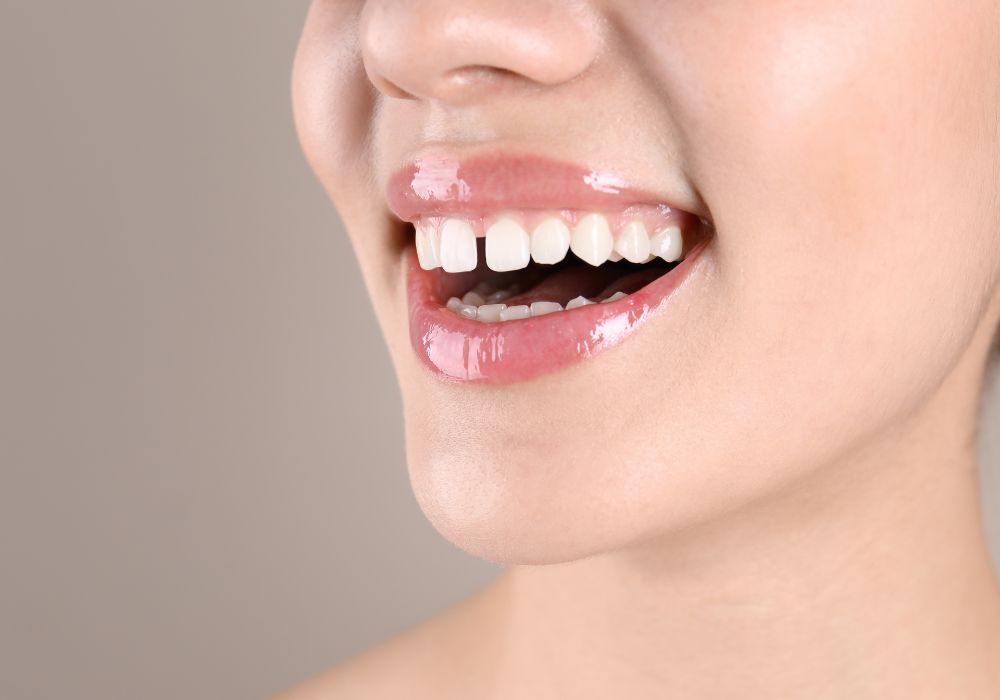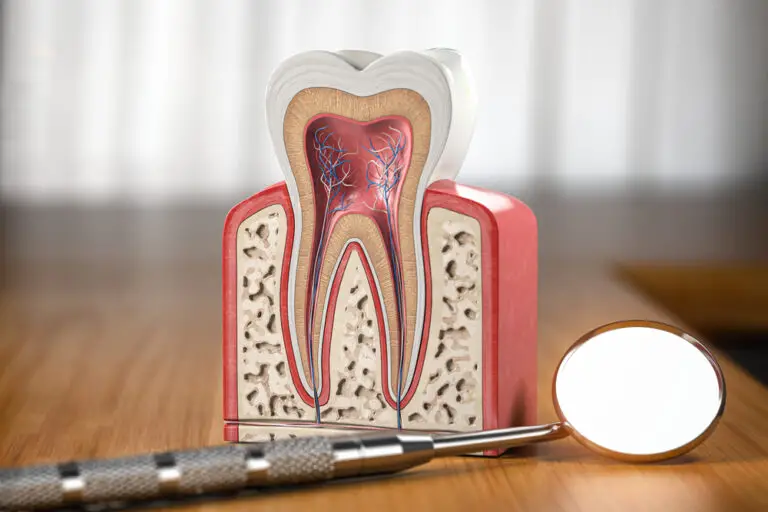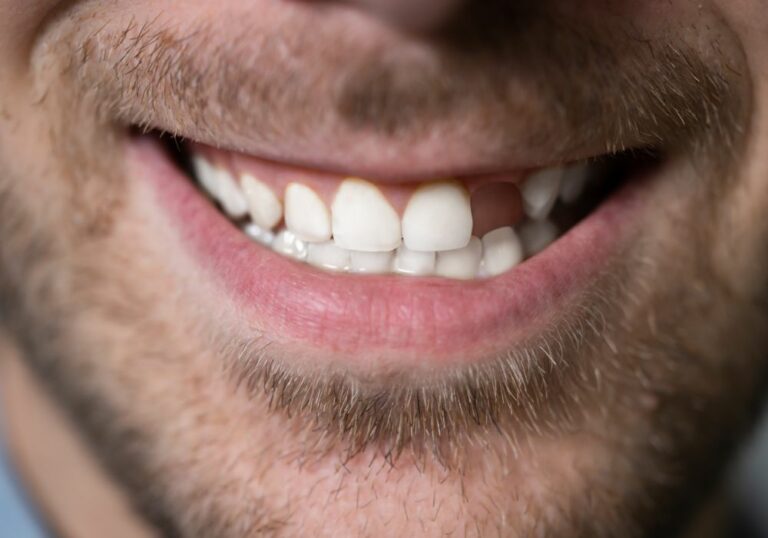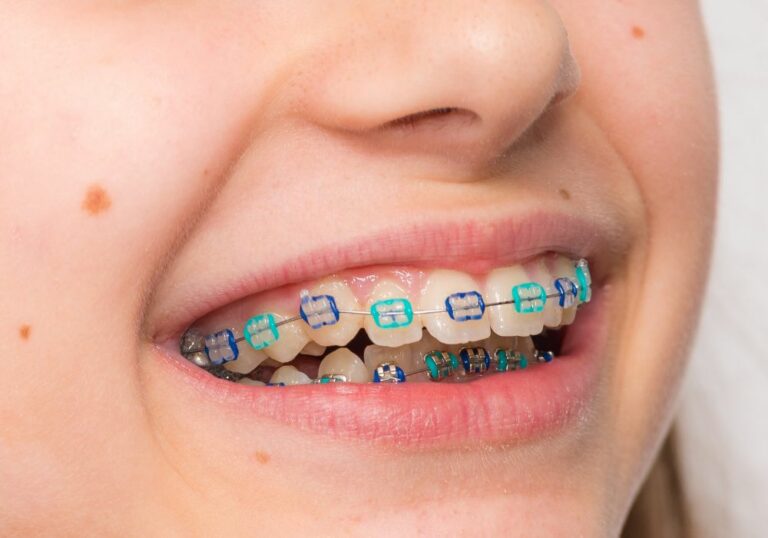Having a space or gap between the two upper front teeth is a common dental condition referred to as diastema. While often casually called a “gap tooth”, diastema is the technical term used to describe this type of dental spacing.
Diastema ranges from mild spacing between the teeth to a wide gap that is quite noticeable. Most people have mild teeth spacing to some degree as no one has perfectly aligned teeth. But significant diastema is an aesthetic concern for many individuals.
Although the gap is most obvious between the two upper front incisors, diastema can occur between any two teeth. The space can involve just the teeth or both the teeth and the underlying bone.
What Causes Diastema?

There are a number of possible causes of diastema, ranging from normal growth patterns to congenital conditions. Determining the cause of diastema requires a clinical exam by a dentist or orthodontist.
Normal Growth and Development
Diastema is often caused by normal growth and developmental changes in the structure and size of the jaw bones and eruption of the teeth.
- In children, a gap is common between the two upper primary (baby) incisor teeth. This normal gap will typically close as the jaw grows and permanent incisors erupt around age 6-7.
- However, it is also common for a diastema to develop again later between the permanent (adult) incisors during childhood mixed dentition. This occurs as the permanent teeth come in and the jaw growth is not yet complete. Again, the diastema usually closes on its own as the child approaches adolescence.
- By age 9-12, as jaw growth stabilizes and all permanent teeth have erupted, most cases of diastema resolve on their own without intervention. However, cases that persist beyond this point will likely require orthodontic treatment.
Oversized Labial Frenum
The labial frenum is the band of tissue located between the inner upper lip and gum, directly above the front teeth. This frenum should remain relatively tight against the gum tissue.
However, in some cases, the labial frenum is overly large or the attachment is too far down on the gums. This creates a large gap or “V” shape between the gum and the frenum attachment when lifting the lip.
When present, this oversized frenum can prevent the front teeth from fully closing together, causing or contributing to diastema. Surgically revising the frenum (frenectomy) is often needed in conjunction with orthodontic treatment to allow proper dental closure.
Missing or Undersized Teeth
Congenitally missing teeth or abnormally small teeth can lead to diastema due to insufficient space being occupied in the dental arch.
- The most common scenario is a missing or peg-shaped (very small) lateral incisor, leaving a gap between the upper central incisors.
- Unlike normal spacing from growth, diastema caused by missing or small teeth will not resolve on its own without orthodontic closure of the space.
Overgrowth of Jaw Bones
In very rare cases, overgrowth of the upper jaw bone can lead to excessive space between the teeth. Conditions like gigantism, acromegaly, or tumors cause an abnormal enlargement of the upper jaw that prevents proper dental closure.
Undergrowth of the upper jaw can also contribute to diastema by not allowing adequate space for the teeth to fit together properly.
Habits
Prolonged habits like thumb sucking, tongue thrusting, and lower lip sucking can also cause space between the front teeth to develop.
These habits exert abnormal pressure against the front teeth, gradually pushing them forward out of alignment. This effect is most significant after the permanent teeth have erupted when the teeth are more susceptible to shifting. Breaking the habit is necessary to prevent a worsening diastema.
Other Causes
Less common causes of diastema include:
- Cleft lip and/or palate
- Abnormally positioned tooth buds
- Supernumerary (extra) teeth
- Dental trauma causing loss of tooth structure
- Tooth size-arch length discrepancies
- Periodontal (gum) disease
- Abnormal swallowing pattern
Determining the definitive cause requires an oral exam by a dental professional. The cause directs the proper treatment approach.
Signs and Symptoms of Diastema
Signs and symptoms of diastema affecting the upper front teeth include:
- Visible gap or space between two teeth
- Teeth appear to be spreading apart
- Food impaction between teeth
- Tongue protrusion through the gap
- Whistle or lisp on “s” or “th” sounds
- V-shaped gap in the gum when lifting upper lip
- Presence of peg-shaped or undersized teeth
- Missing permanent teeth coming in
Symptoms are mainly aesthetic in nature or related to food retention issues. However, diastema can contribute to gum inflammation and progressive dental decay without treatment.
Potential Complications of Untreated Diastema

While diastema seems like primarily a cosmetic problem, leaving spaces long term can lead to complications:
- Plaque buildup – The gap allows increased plaque accumulation as food debris tightly packs into the space between the teeth. This spike in plaque heightens risk of tooth decay.
- Gum disease – The plaque and calculus buildup leads to gingivitis and can progress to periodontal disease with receding gums.
- Tooth tipping – Lack of contact between the teeth enables the front teeth to shift and tip into the open space over time.
- Bone loss – The open space leads to bone loss around the teeth due to lack of stimulation.
- Speech issues – Diastema can cause a whistle or lisp on “s” or “th” sounds as air escapes through the gap.
- TMJ problems – Misaligned front teeth or a gap can interfere with proper bite alignment and function, straining the temporomandibular joint.
- Dental fractures – Teeth adjacent to diastema are at higher risk of fracture and chipping due to lack of support.
- Decay in missing teeth spaces – Diastema caused by missing teeth can allow food packing between the teeth, becoming decayed over time.
- Need for complex treatment – Waiting too long for treatment often necessitates more invasive, complex correction methods to fix additional issues that arise.
Diastema Diagnosis and Evaluation
In order to determine the optimal treatment plan, an orthodontist will conduct a thorough clinical exam of the teeth, gums, jaw alignment, and bite. Common diagnostic procedures include:
- Visual examination of the spacing and position of all teeth in the arches
- Evaluation of the labial frenum attachment site
- Assessment of overbite and overjet
- Palpation of the gums and jaw joints
- Analysis of dental casts or digital models of the teeth
- Panoramic x-rays to visualize all teeth, jaws, and erupted status
- Cephalometric x-rays to examine jaw angles and skeletal profile
- Intraoral photographs and videos to document diastema before treatment
- Tracking growth patterns on pediatric patients
The orthodontist considers the patient’s age, cause of diastema, status of permanent teeth, jaw development stage, and overall oral health during the evaluation.
When Should Diastema Be Treated?
Childhood Diastema
For most children, adopting a “wait and see” approach for diastema involving the upper baby teeth is prudent. As long as there are no overgrown frenum or habits present, these spaces tend to close naturally as the permanent incisors erupt and jaws develop.
However, prompt consultation is indicated if:
- Diastema worsens or fails to close after eruption of permanent incisors
- Permanent tooth buds appear poorly positioned or impacted
- Missing or unusually small permanent tooth buds are detected
- Tongue thrusting or other habits are present
If diastema persists into the teen years, orthodontic intervention will likely be required for closure.
Teens and Adults
In teens and adults, diastema involving the permanent teeth has a low probability of closing spontaneously. At these stages, correction requires:
- Orthodontic treatment to align the teeth and close diastema
- Dental restoration to modify tooth size/shape if indicated
- Permanent retention to prevent relapse
The benefits of earlier orthodontic treatment while jaw growth is still favorable must be balanced with allowing maturity of the permanent dentition. Most orthodontists recommend intervening around age 13-14 if diastema fails to self-correct.
Orthodontic Treatment Options
Orthodontics moves the teeth into optimal alignment while closing the diastema. Several appliance options exist:
- Braces – Traditional metal or ceramic braces remain the gold standard treatment. Braces utilize brackets, wires and elastics to gently move teeth into closure over 12-24 months.
- Clear aligners – Popular clear aligners like Invisalign are also effective for closing diastema. Aligners are worn in a series over 6-18 months to gradually shift teeth.
- Lingual braces – Braces attached to the tongue-side of teeth are an esthetic option. Unnoticeable from the outside but less convenient inside the mouth.
- Retainers – After orthodontics, a permanent bonded retainer behind the front teeth prevents relapse of diastema. Removable retainers may supplement while sleeping.
- Surgical exposure of impacted teeth – Orthodontics coupled with surgical exposure of poorly positioned tooth buds may be necessary in some scenarios.
The orthodontist will determine which appliance choice is right based on the case complexity, motivation level, and esthetic demands of the patient.
Dental Restorative Options

Restorative dental treatments may play a role in managing diastema:
- Dental bonding – Tooth-colored resin material is applied to the sides of teeth to reshape and close space. Provides a quick fix but cannot properly align teeth.
- Porcelain veneers – Thin porcelain facings are bonded to teeth to lengthen and create symmetry. More invasive but highly esthetic and durable.
- Crowns – Encircle the tooth for complete contouring. Indicated for malformed or fractured teeth adjacent to diastema.
- Implants – Titanium implants supporting a crown replace missing teeth that may be causing diastema. Provides like-natural tooth replacement.
- Composite buildups – Add composite material to teeth to reshape smaller teeth like peg laterals. More conservative than veneers or crowns.
These approaches may be combined with orthodontics or utilized on their own in selective cases, depending on the requirements after consultation.
Diastema Treatment Sequence
- Oral hygiene optimization – Good oral hygiene is imperative prior to appliance therapy to prevent white spot lesions and decay.
- Habit intervention – Cessation of tongue thrusting, thumb sucking, etc. is necessary before proceeding with orthodontics.
- Frenectomy – Releasing an overgrown frenum often facilitates space closure.
- Orthodontic treatment – Corrects underlying malocclusion for long-term stability.
- Retention – Critical to prevent recurrence of diastema after orthodontics.
- Restorative care – Bonding, veneers, implants or crowns may refine shape, symmetry and esthetics after orthodontic closure.
The combination and sequence of these steps are tailored to the individual patient for optimal correction of the diastema. Excellent communication between the orthodontist and restorative dentist ensures properly coordinated care.
Maintaining Diastema Closure Long-Term
Successfully treated diastema has a tendency to relapse, especially in non-compliant patients. The following steps promote long-term maintenance:
- Retainer wear – Wearing a fixed retainer behind the front teeth full-time for 1-2 years is ideal, in addition to nighttime removable retainers.
- Prompt repair of dislodged retainers – Breakage or loosening of retainers must be addressed immediately to avoid teeth shifting.
- Regular dental visits – Routine exams every 6 months enable early detection of orthodontic relapse or dental decay between teeth.
- Proper home care – Brushing carefully between front teeth and flossing daily is imperative. Regular use of proxybrushes, stimudents or irrigators helps cleanse the tight space.
- Avoid tongue habits – Consciously keeping tongue resting on the palate instead of thrusting can help prevent relapse.
- Wear mouthguard with impact sports – Protects alignment and prevents teeth fracturing and diastema recurrence.
- Long term retention – May require wearing removable or fixed retainers at night long-term to prevent slight scar tissue “rebound.”
Commitment to retention and protective steps lessens the chance of new spaces opening after orthodontic closure.
Diastema FAQs
Q1: Will a childhood diastema close on its own?
A diastema between baby teeth often closes after the permanent incisors emerge. Spacing between permanent incisors also frequently closes on its own by age 9-12 as the jaws develop. However, if the gap remains beyond age 12-14, orthodontic treatment will likely be required for closure.
Q2: Can a labial frenectomy help close diastema?
Yes, surgically revising an overgrown or damaged frenum can assist with diastema closure by releasing the tethered tissue. This is often done in conjunction with orthodontics or dental restorations for complete closure.
Q3: How long does it take braces to close a gap between front teeth?
Treatment times range from 12-24 months depending on the original gap width, compliance with elastic wear, and rate of tooth movement. Wider spaces take longer to close than minor diastema. Teens generally achieve faster closure than adults.
Q4: Will a diastema between my front teeth get worse?
If diastema results from an abnormal frenum attachment, missing teeth, or detrimental habits, the gap can often worsen over time without treatment. However, childhood spacing from normal growth rarely worsens significantly. An orthodontist can determine if your diastema requires timely intervention.
Q5: Can Invisalign work as well as braces to close a gap?
Yes, clear aligners have proven highly effective for closing diastema. Aligners utilize the same forces as braces to move teeth and are able to achieve similar space closure over a series of trays worn full-time. An orthodontist can advise which option will work optimally for your particular diastema case.
Q6: Will my diastema return after orthodontic treatment?
Fixed retainers are recommended for at least 1-2 years after braces to prevent relapse of closed diastema. Non-compliance with retainer wear and persistence of habits like tongue thrusting can allow spaces to reopen. Commitment to retention and avoiding harmful habits is key to maintaining long-term closure.
Q7: Can a dental implant be placed to fill the space of diastema?
Dental implants are an option to replace single missing teeth that are causing diastema. An implant permanently fills the space, unlike a traditional bridge which requires abutment teeth grinding. When diastema results from missing teeth, implants provide excellent function and stability.
Q8: At what age is it too late to close a gap between front teeth?
It’s never too late for diastema treatment! Options like clear aligners and porcelain veneers enable minimally invasive correction even for older adults. However, addressing diastema earlier when bone support is more robust provides the most predictable long-term results from orthodontic treatment.
Q9: Can braces close diastema in just 6 months?
Treatment times under 12 months are very unlikely, even for minor spacing. Moving teeth requires gradual, incremental progress through bone. Average treatment lengths are 18-24 months for complete diastema closure and finishing with braces. Faster options like aligners or restorations alone may give quicker results, but stability may be compromised.
Q10: Will my diastema keep coming back after it’s closed?
With proper long-term retention, attention to habits, and ongoing dental care, recurrence of closed diastema is very unlikely. However, short-term (6 months) retention or intermittent retainer wear can allow spaces to slowly reopen. Consistent retainer use as directed long-term and protecting alignment from impacts prevents relapse of corrected diastema for the vast majority of patients.
Conclusion
In summary, diastema or spacing between front teeth is a common orthodontic condition with a variety of etiologies. Mild to moderate childhood diastema often resolves spontaneously with jaw growth. However, larger persistent spacing in adults generally warrants treatment to close the gap.
With a combination of proper orthodontic alignment, frenectomy when indicated, restorative procedures as needed, and diligent retention, diastema can be corrected safely and effectively. Seeking treatment in the teenage years provides timely intervention with optimal bone support. But adults can also benefit from today’s precise realignment options.
Left untreated, diastema can contribute to plaque retention, progressive dental decay and bone loss over the long run. Committing to closure and ongoing retention provides excellent long-term dental health and improved smile esthetics.







